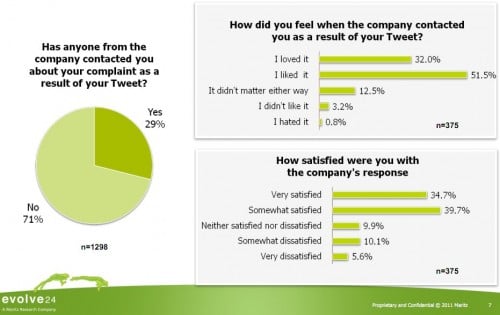“Despite increasing numbers of customers using Twitter to publicly complain about brands, the vast majority of companies respond in the exact same way….with the quiet of contempt” … from Jay Baer’s Convince & Convert
70% of Companies Ignore Customer Complaints on Twitter
This is an excellent reminder of the folly of ignoring what social media offers all of us in terms of customer service and reputation management – and the dangers of ignoring it!

Despite increasing numbers of customers using Twitter to publicly complain about brands, the vast majority of companies respond in the exact same way….with the quiet of contempt.
“This is a dereliction of duty, in my estimation. Brands must look at these new channels as the “social telephone” and ignoring these 140 character cries for help is a flawed decision for two reasons.
First, responding to Twitter complaints can turn lemons into lemonade. The Maritz study found that 83% of the complainants that received a reply liked or loved the fact that the company responded. This is irrespective of how, when or why the response came. Think about that. Just the fact that the company acknowledged the problem and showed it was listening improved customer psychology 83% of the time.
“What is striking about these findings is the strong degree to which consumers want to be engaged online to have their issues addressed,” says Anthony Sardella, senior vice president and managing director at evolve24. “They are clearly seeking to have a greater voice in the customer service process and see social media as a streamlined means for resolution of their issues.”
Second, the people that are using Twitter to complain are already disproportionately upset. Previous research from ExactTarget called Twitter X-Factors showed that fewer than 1% of customers use Twitter as their first stop in problem resolution. In almost every case, the people complaining on Twitter are doing so because your company already failed to satisfy them in one or more traditional customer service channels.
Let’s see if I have this right. Angry customers just looking for a sympathetic ear, shouting about it in a public forum. That does not seem to me to be an equation that 70% of companies should ignore.”
Why is this happening? Back to Jay…
“Fear. Companies literally believe (and I hear this exact phrase all the time) that they’d like to get involved but are afraid the conversation will turn negative in social media, and that answering gives greater exposure to complaints. Here’s the deal. If your company sucks, Twitter is the least of your worries. Social media doesn’t create negativity, it puts a magnifying glass to it. Twitter doesn’t make people more upset, it makes them less upset (if you respond) – especially women 35+ who are disproportionately delighted to get a response on Twitter from a brand.
Resources. It’s true that social media doesn’t close at 5pm, and in fact many customers use social media during the night and on weekends, when it may be inconvenient for you to monitor and reply. But your corporate convenience is not the prism through which you should be gazing upon social business. There was a time when grocery stores closed at 10pm, catalog call centers weren’t open on the weekend, and the only companies that had websites were in porn. But the world has changed – not to throw a wrench into your carefully crafted staffing and resource allocation model – but because the needs and desires of your customers have changed.
Customer Satisfaction with Operating Efficiencies
Also recognize that while you may need to expand your “paying attention” windows to meet the new customer expectations social media has wrought, you can also handle customer issues with greater efficiency. Sure, you only have 140 characters to reply, but your customer only has 140 characters to gripe. Do you think Comcast does Twitter customer service solely because they are nice guys and/or want to get newspaper coverage about doing so? They do Twitter customer service because it’s more efficient than telephone or email customer service.
This isn’t that hard. This is not out of reach for 70% of companies. You need to listen, respond, and triage. I know they just look like tiny little heads floating across your computer, but these are real people. They are your customers. They are not happy.
Your silence is deafening.”
This is a situation your business cannot afford to ignore. What help do you need to get this working for you?


